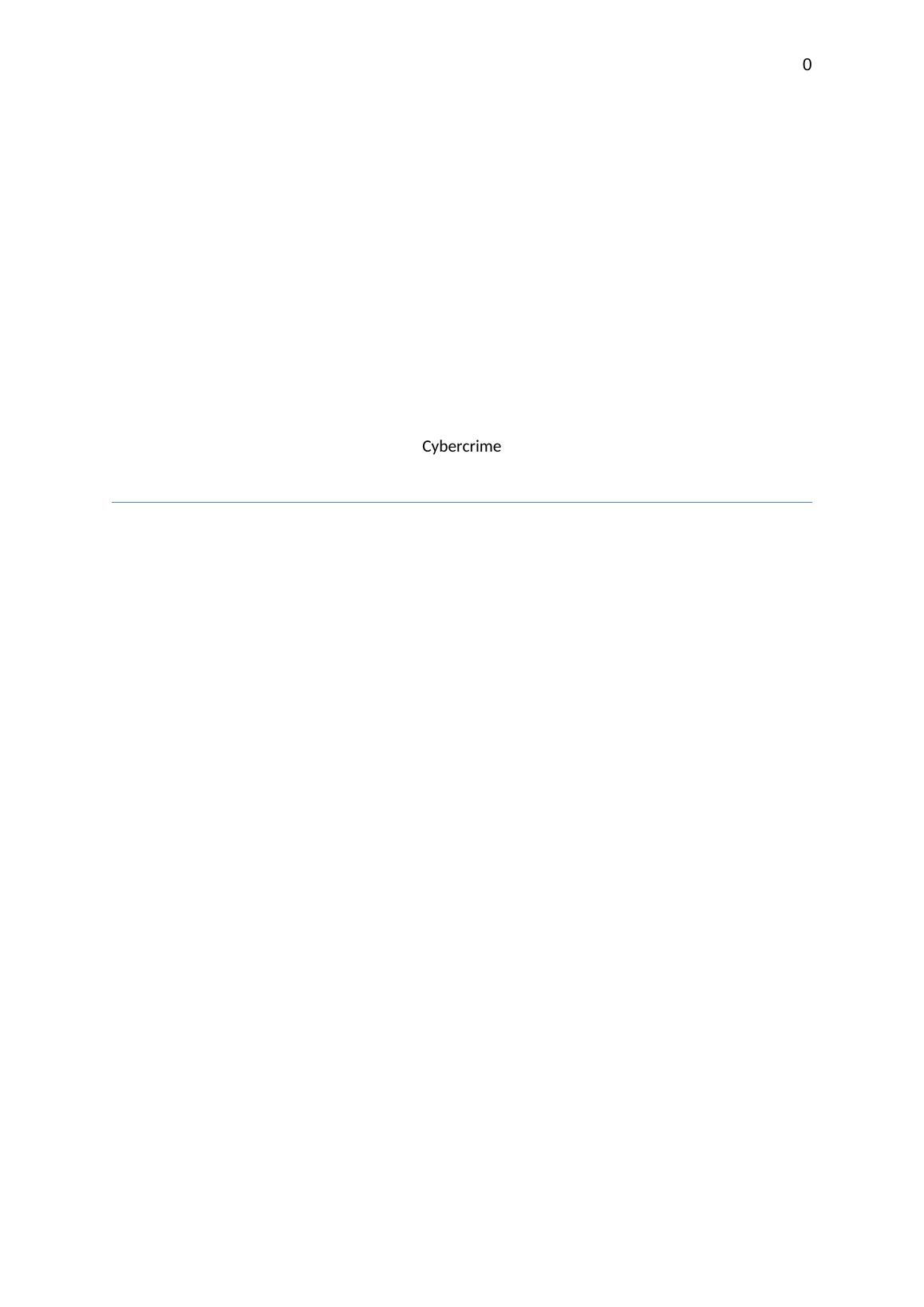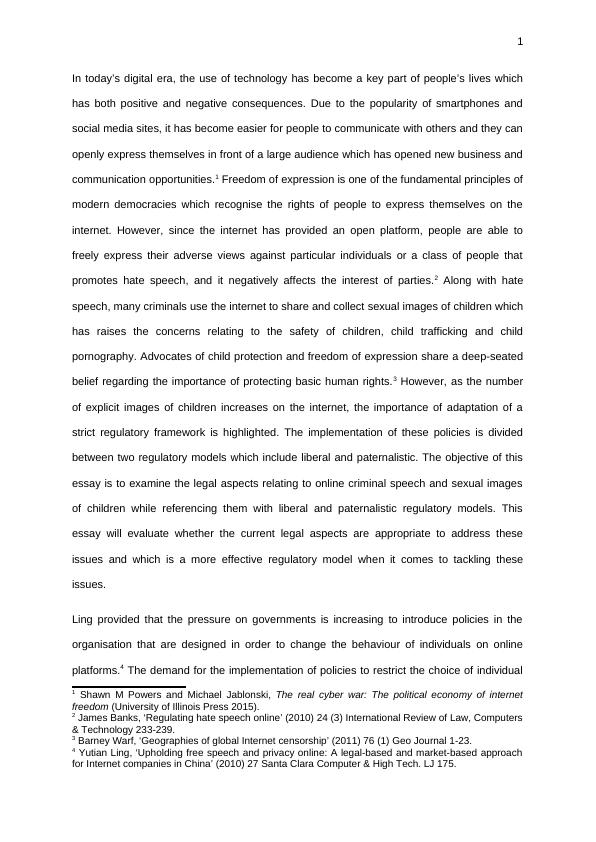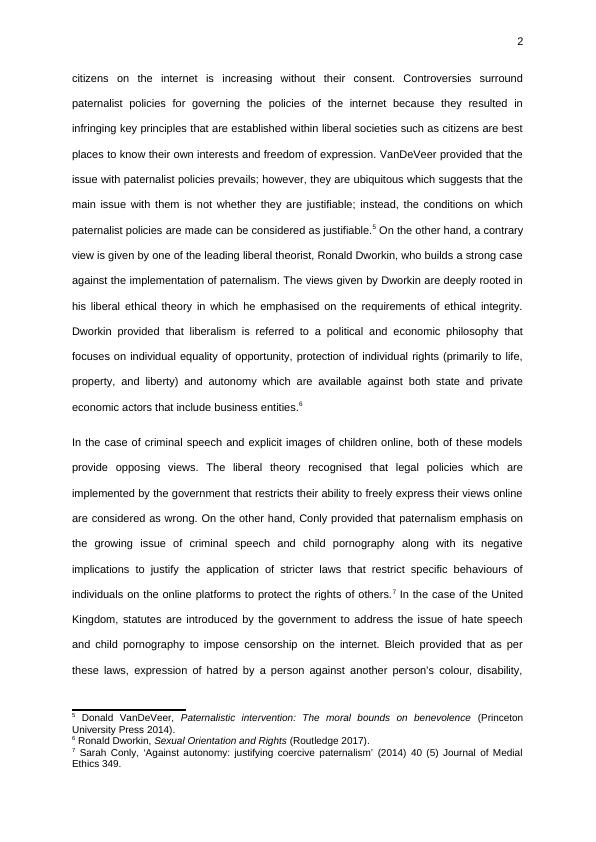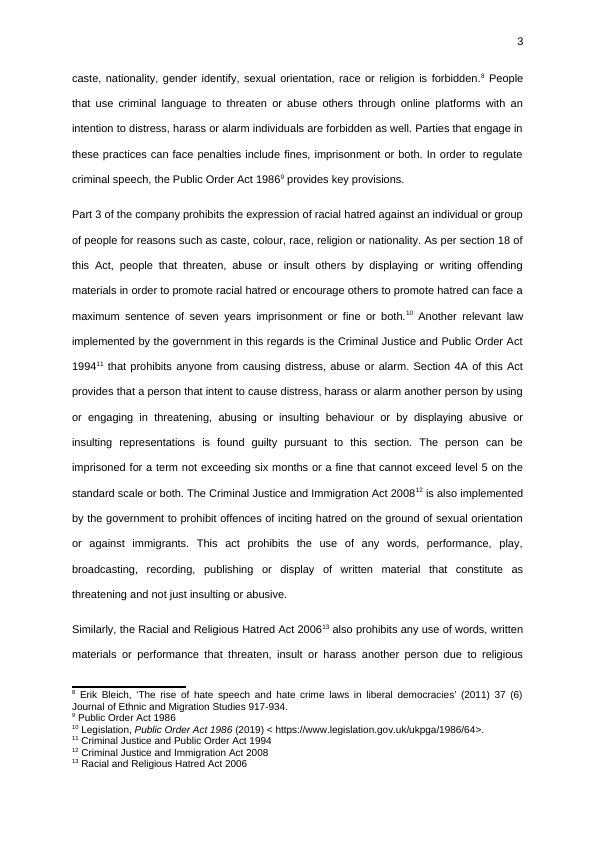Legal Aspects of Online Criminal Speech and Sexual Images of Children
Critically examine the legal aspects of both sexual images of children and criminal speech online with reference to liberal and paternalistic regulatory models.
13 Pages3995 Words50 Views
Added on 2023-01-16
About This Document
This essay examines the legal aspects relating to online criminal speech and sexual images of children while referencing them with liberal and paternalistic regulatory models.
Legal Aspects of Online Criminal Speech and Sexual Images of Children
Critically examine the legal aspects of both sexual images of children and criminal speech online with reference to liberal and paternalistic regulatory models.
Added on 2023-01-16
ShareRelated Documents
0
Cybercrime
Cybercrime

1
In today’s digital era, the use of technology has become a key part of people’s lives which
has both positive and negative consequences. Due to the popularity of smartphones and
social media sites, it has become easier for people to communicate with others and they can
openly express themselves in front of a large audience which has opened new business and
communication opportunities.1 Freedom of expression is one of the fundamental principles of
modern democracies which recognise the rights of people to express themselves on the
internet. However, since the internet has provided an open platform, people are able to
freely express their adverse views against particular individuals or a class of people that
promotes hate speech, and it negatively affects the interest of parties.2 Along with hate
speech, many criminals use the internet to share and collect sexual images of children which
has raises the concerns relating to the safety of children, child trafficking and child
pornography. Advocates of child protection and freedom of expression share a deep-seated
belief regarding the importance of protecting basic human rights.3 However, as the number
of explicit images of children increases on the internet, the importance of adaptation of a
strict regulatory framework is highlighted. The implementation of these policies is divided
between two regulatory models which include liberal and paternalistic. The objective of this
essay is to examine the legal aspects relating to online criminal speech and sexual images
of children while referencing them with liberal and paternalistic regulatory models. This
essay will evaluate whether the current legal aspects are appropriate to address these
issues and which is a more effective regulatory model when it comes to tackling these
issues.
Ling provided that the pressure on governments is increasing to introduce policies in the
organisation that are designed in order to change the behaviour of individuals on online
platforms.4 The demand for the implementation of policies to restrict the choice of individual
1 Shawn M Powers and Michael Jablonski, The real cyber war: The political economy of internet
freedom (University of Illinois Press 2015).
2 James Banks, ‘Regulating hate speech online’ (2010) 24 (3) International Review of Law, Computers
& Technology 233-239.
3 Barney Warf, ‘Geographies of global Internet censorship’ (2011) 76 (1) Geo Journal 1-23.
4 Yutian Ling, ‘Upholding free speech and privacy online: A legal-based and market-based approach
for Internet companies in China’ (2010) 27 Santa Clara Computer & High Tech. LJ 175.
In today’s digital era, the use of technology has become a key part of people’s lives which
has both positive and negative consequences. Due to the popularity of smartphones and
social media sites, it has become easier for people to communicate with others and they can
openly express themselves in front of a large audience which has opened new business and
communication opportunities.1 Freedom of expression is one of the fundamental principles of
modern democracies which recognise the rights of people to express themselves on the
internet. However, since the internet has provided an open platform, people are able to
freely express their adverse views against particular individuals or a class of people that
promotes hate speech, and it negatively affects the interest of parties.2 Along with hate
speech, many criminals use the internet to share and collect sexual images of children which
has raises the concerns relating to the safety of children, child trafficking and child
pornography. Advocates of child protection and freedom of expression share a deep-seated
belief regarding the importance of protecting basic human rights.3 However, as the number
of explicit images of children increases on the internet, the importance of adaptation of a
strict regulatory framework is highlighted. The implementation of these policies is divided
between two regulatory models which include liberal and paternalistic. The objective of this
essay is to examine the legal aspects relating to online criminal speech and sexual images
of children while referencing them with liberal and paternalistic regulatory models. This
essay will evaluate whether the current legal aspects are appropriate to address these
issues and which is a more effective regulatory model when it comes to tackling these
issues.
Ling provided that the pressure on governments is increasing to introduce policies in the
organisation that are designed in order to change the behaviour of individuals on online
platforms.4 The demand for the implementation of policies to restrict the choice of individual
1 Shawn M Powers and Michael Jablonski, The real cyber war: The political economy of internet
freedom (University of Illinois Press 2015).
2 James Banks, ‘Regulating hate speech online’ (2010) 24 (3) International Review of Law, Computers
& Technology 233-239.
3 Barney Warf, ‘Geographies of global Internet censorship’ (2011) 76 (1) Geo Journal 1-23.
4 Yutian Ling, ‘Upholding free speech and privacy online: A legal-based and market-based approach
for Internet companies in China’ (2010) 27 Santa Clara Computer & High Tech. LJ 175.

2
citizens on the internet is increasing without their consent. Controversies surround
paternalist policies for governing the policies of the internet because they resulted in
infringing key principles that are established within liberal societies such as citizens are best
places to know their own interests and freedom of expression. VanDeVeer provided that the
issue with paternalist policies prevails; however, they are ubiquitous which suggests that the
main issue with them is not whether they are justifiable; instead, the conditions on which
paternalist policies are made can be considered as justifiable.5 On the other hand, a contrary
view is given by one of the leading liberal theorist, Ronald Dworkin, who builds a strong case
against the implementation of paternalism. The views given by Dworkin are deeply rooted in
his liberal ethical theory in which he emphasised on the requirements of ethical integrity.
Dworkin provided that liberalism is referred to a political and economic philosophy that
focuses on individual equality of opportunity, protection of individual rights (primarily to life,
property, and liberty) and autonomy which are available against both state and private
economic actors that include business entities.6
In the case of criminal speech and explicit images of children online, both of these models
provide opposing views. The liberal theory recognised that legal policies which are
implemented by the government that restricts their ability to freely express their views online
are considered as wrong. On the other hand, Conly provided that paternalism emphasis on
the growing issue of criminal speech and child pornography along with its negative
implications to justify the application of stricter laws that restrict specific behaviours of
individuals on the online platforms to protect the rights of others.7 In the case of the United
Kingdom, statutes are introduced by the government to address the issue of hate speech
and child pornography to impose censorship on the internet. Bleich provided that as per
these laws, expression of hatred by a person against another person’s colour, disability,
5 Donald VanDeVeer, Paternalistic intervention: The moral bounds on benevolence (Princeton
University Press 2014).
6 Ronald Dworkin, Sexual Orientation and Rights (Routledge 2017).
7 Sarah Conly, ‘Against autonomy: justifying coercive paternalism’ (2014) 40 (5) Journal of Medial
Ethics 349.
citizens on the internet is increasing without their consent. Controversies surround
paternalist policies for governing the policies of the internet because they resulted in
infringing key principles that are established within liberal societies such as citizens are best
places to know their own interests and freedom of expression. VanDeVeer provided that the
issue with paternalist policies prevails; however, they are ubiquitous which suggests that the
main issue with them is not whether they are justifiable; instead, the conditions on which
paternalist policies are made can be considered as justifiable.5 On the other hand, a contrary
view is given by one of the leading liberal theorist, Ronald Dworkin, who builds a strong case
against the implementation of paternalism. The views given by Dworkin are deeply rooted in
his liberal ethical theory in which he emphasised on the requirements of ethical integrity.
Dworkin provided that liberalism is referred to a political and economic philosophy that
focuses on individual equality of opportunity, protection of individual rights (primarily to life,
property, and liberty) and autonomy which are available against both state and private
economic actors that include business entities.6
In the case of criminal speech and explicit images of children online, both of these models
provide opposing views. The liberal theory recognised that legal policies which are
implemented by the government that restricts their ability to freely express their views online
are considered as wrong. On the other hand, Conly provided that paternalism emphasis on
the growing issue of criminal speech and child pornography along with its negative
implications to justify the application of stricter laws that restrict specific behaviours of
individuals on the online platforms to protect the rights of others.7 In the case of the United
Kingdom, statutes are introduced by the government to address the issue of hate speech
and child pornography to impose censorship on the internet. Bleich provided that as per
these laws, expression of hatred by a person against another person’s colour, disability,
5 Donald VanDeVeer, Paternalistic intervention: The moral bounds on benevolence (Princeton
University Press 2014).
6 Ronald Dworkin, Sexual Orientation and Rights (Routledge 2017).
7 Sarah Conly, ‘Against autonomy: justifying coercive paternalism’ (2014) 40 (5) Journal of Medial
Ethics 349.

3
caste, nationality, gender identify, sexual orientation, race or religion is forbidden.8 People
that use criminal language to threaten or abuse others through online platforms with an
intention to distress, harass or alarm individuals are forbidden as well. Parties that engage in
these practices can face penalties include fines, imprisonment or both. In order to regulate
criminal speech, the Public Order Act 19869 provides key provisions.
Part 3 of the company prohibits the expression of racial hatred against an individual or group
of people for reasons such as caste, colour, race, religion or nationality. As per section 18 of
this Act, people that threaten, abuse or insult others by displaying or writing offending
materials in order to promote racial hatred or encourage others to promote hatred can face a
maximum sentence of seven years imprisonment or fine or both.10 Another relevant law
implemented by the government in this regards is the Criminal Justice and Public Order Act
199411 that prohibits anyone from causing distress, abuse or alarm. Section 4A of this Act
provides that a person that intent to cause distress, harass or alarm another person by using
or engaging in threatening, abusing or insulting behaviour or by displaying abusive or
insulting representations is found guilty pursuant to this section. The person can be
imprisoned for a term not exceeding six months or a fine that cannot exceed level 5 on the
standard scale or both. The Criminal Justice and Immigration Act 200812 is also implemented
by the government to prohibit offences of inciting hatred on the ground of sexual orientation
or against immigrants. This act prohibits the use of any words, performance, play,
broadcasting, recording, publishing or display of written material that constitute as
threatening and not just insulting or abusive.
Similarly, the Racial and Religious Hatred Act 200613 also prohibits any use of words, written
materials or performance that threaten, insult or harass another person due to religious
8 Erik Bleich, ‘The rise of hate speech and hate crime laws in liberal democracies’ (2011) 37 (6)
Journal of Ethnic and Migration Studies 917-934.
9 Public Order Act 1986
10 Legislation, Public Order Act 1986 (2019) < https://www.legislation.gov.uk/ukpga/1986/64>.
11 Criminal Justice and Public Order Act 1994
12 Criminal Justice and Immigration Act 2008
13 Racial and Religious Hatred Act 2006
caste, nationality, gender identify, sexual orientation, race or religion is forbidden.8 People
that use criminal language to threaten or abuse others through online platforms with an
intention to distress, harass or alarm individuals are forbidden as well. Parties that engage in
these practices can face penalties include fines, imprisonment or both. In order to regulate
criminal speech, the Public Order Act 19869 provides key provisions.
Part 3 of the company prohibits the expression of racial hatred against an individual or group
of people for reasons such as caste, colour, race, religion or nationality. As per section 18 of
this Act, people that threaten, abuse or insult others by displaying or writing offending
materials in order to promote racial hatred or encourage others to promote hatred can face a
maximum sentence of seven years imprisonment or fine or both.10 Another relevant law
implemented by the government in this regards is the Criminal Justice and Public Order Act
199411 that prohibits anyone from causing distress, abuse or alarm. Section 4A of this Act
provides that a person that intent to cause distress, harass or alarm another person by using
or engaging in threatening, abusing or insulting behaviour or by displaying abusive or
insulting representations is found guilty pursuant to this section. The person can be
imprisoned for a term not exceeding six months or a fine that cannot exceed level 5 on the
standard scale or both. The Criminal Justice and Immigration Act 200812 is also implemented
by the government to prohibit offences of inciting hatred on the ground of sexual orientation
or against immigrants. This act prohibits the use of any words, performance, play,
broadcasting, recording, publishing or display of written material that constitute as
threatening and not just insulting or abusive.
Similarly, the Racial and Religious Hatred Act 200613 also prohibits any use of words, written
materials or performance that threaten, insult or harass another person due to religious
8 Erik Bleich, ‘The rise of hate speech and hate crime laws in liberal democracies’ (2011) 37 (6)
Journal of Ethnic and Migration Studies 917-934.
9 Public Order Act 1986
10 Legislation, Public Order Act 1986 (2019) < https://www.legislation.gov.uk/ukpga/1986/64>.
11 Criminal Justice and Public Order Act 1994
12 Criminal Justice and Immigration Act 2008
13 Racial and Religious Hatred Act 2006

End of preview
Want to access all the pages? Upload your documents or become a member.
Related Documents
Criminal Justice Research 2022lg...
|7
|1520
|11
IT Write Up Preparation for Professional Practices Discussion 2022lg...
|6
|1911
|19
Free Speech Vs Hate Speechlg...
|6
|1352
|447
Threat to Democratic Rightslg...
|12
|2899
|233
Cybercrime: Understanding Cyber-Dependent and Cyber-Enabled Crimeslg...
|11
|3420
|335
Adequacy of Current Cyber Bullying Laws in Criminal Codelg...
|7
|1681
|53
